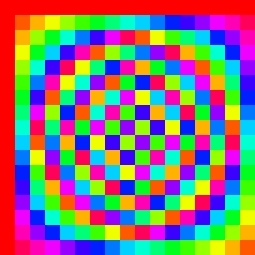Cayley Tables

A Cayley Table is a multiplication table for a group. This sounds simple however some interesting patterns and things come from this.
For example take the integers modulo 3, denoted as \(\Bbb Z_3\). Let's define multiplication in the usual sense. You will find that this forms a group (you can check this).
Now writing the elements of the group out in Lexicographical order we can form a table.
Now we simply fill it in by applying the multiplication to the corresponding elements in the rows and columns in the table. You should have:
Now if I colour the elements lexicographically we can see a pattern emerge (more clearly).
We can go further and assume lexicographical order (of some sort) and remove the reference rows and columns.
The interesting thing is, is that we can do this for any group and reveal some of it's symmetries and patterns.
Over the next few days I shall be releasing the coloured Cayley tables for some groups that I have generated. We shall start of with simpler groups and eventually get more complicated. But first:
The Image at the top of the post is the Cayley Table for
Easy Math Editor
This discussion board is a place to discuss our Daily Challenges and the math and science related to those challenges. Explanations are more than just a solution — they should explain the steps and thinking strategies that you used to obtain the solution. Comments should further the discussion of math and science.
When posting on Brilliant:
*italics*or_italics_**bold**or__bold__paragraph 1
paragraph 2
[example link](https://brilliant.org)> This is a quote# I indented these lines # 4 spaces, and now they show # up as a code block. print "hello world"\(...\)or\[...\]to ensure proper formatting.2 \times 32^{34}a_{i-1}\frac{2}{3}\sqrt{2}\sum_{i=1}^3\sin \theta\boxed{123}Comments
There are no comments in this discussion.